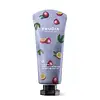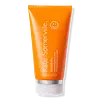What's inside
What's inside
 Key Ingredients
Key Ingredients

 Benefits
Benefits

 Concerns
Concerns

 Ingredients Side-by-side
Ingredients Side-by-side

Water
Skin ConditioningGlycerin
HumectantCetyl Alcohol
EmollientParaffinum Liquidum
EmollientDipropylene Glycol
HumectantDimethicone
EmollientCyclopentasiloxane
EmollientStearyl Alcohol
EmollientGlyceryl Stearate
EmollientPEG-100 Stearate
Polysorbate 60
EmulsifyingMyristyl Alcohol
EmollientSorbitan Stearate
EmulsifyingAcrylates/C10-30 Alkyl Acrylate Crosspolymer
Emulsion StabilisingSqualane
EmollientErythritol
HumectantButyrospermum Parkii Butter
Skin ConditioningPunica Granatum Fruit Extract
AntioxidantLauryl Alcohol
EmollientCoco-Caprylate/Caprate
EmollientButylene Glycol
HumectantXanthan Gum
EmulsifyingPotassium Hydroxide
BufferingAdenosine
Skin ConditioningVitis Vinifera Seed Oil
EmollientPrunus Armeniaca Kernel Oil
MaskingPassiflora Edulis Fruit Extract
Skin ConditioningPanthenol
Skin ConditioningSolanum Lycopersicum Seed Oil
EmollientPunica Granatum Seed Oil
EmollientMangifera Indica Seed Oil
EmollientCitrus Paradisi Seed Oil
PerfumingHoney Extract
HumectantCentella Asiatica Extract
CleansingTocopherol
AntioxidantDisodium EDTA
Chlorphenesin
AntimicrobialPhenoxyethanol
Preservative1,2-Hexanediol
Skin ConditioningParfum
MaskingLinalool
PerfumingBenzyl Benzoate
AntimicrobialHexyl Cinnamal
PerfumingLimonene
PerfumingWater, Glycerin, Cetyl Alcohol, Paraffinum Liquidum, Dipropylene Glycol, Dimethicone, Cyclopentasiloxane, Stearyl Alcohol, Glyceryl Stearate, PEG-100 Stearate, Polysorbate 60, Myristyl Alcohol, Sorbitan Stearate, Acrylates/C10-30 Alkyl Acrylate Crosspolymer, Squalane, Erythritol, Butyrospermum Parkii Butter, Punica Granatum Fruit Extract, Lauryl Alcohol, Coco-Caprylate/Caprate, Butylene Glycol, Xanthan Gum, Potassium Hydroxide, Adenosine, Vitis Vinifera Seed Oil, Prunus Armeniaca Kernel Oil, Passiflora Edulis Fruit Extract, Panthenol, Solanum Lycopersicum Seed Oil, Punica Granatum Seed Oil, Mangifera Indica Seed Oil, Citrus Paradisi Seed Oil, Honey Extract, Centella Asiatica Extract, Tocopherol, Disodium EDTA, Chlorphenesin, Phenoxyethanol, 1,2-Hexanediol, Parfum, Linalool, Benzyl Benzoate, Hexyl Cinnamal, Limonene
Water
Skin ConditioningCetyl Ricinoleate
EmollientIsostearyl Palmitate
EmollientDimethicone
EmollientSqualane
EmollientLactic Acid
BufferingGlyceryl Stearate
EmollientPEG-100 Stearate
Propanediol
SolventGlycolic Acid
BufferingMyristyl Alcohol
EmollientCyclopentasiloxane
EmollientSodium Hydroxide
BufferingLactobacillus/Pumpkin Fruit Ferment Filtrate
Skin ConditioningLeuconostoc/Radish Root Ferment Filtrate
AntimicrobialBromelain
Skin ConditioningPapain
Skin ConditioningOpuntia Ficus-Indica Fruit Extract
Skin ConditioningGlycerin
HumectantSaccharomyces Cerevisiae Extract
Skin ConditioningPolysilicone-11
Citrus Aurantium Bergamia Fruit Oil
MaskingAniba Rosodora Wood Extract
MaskingCitrus Aurantium Dulcis Peel Oil
MaskingGeranium Maculatum Oil
MaskingTocopheryl Acetate
AntioxidantPhenoxyethanol
PreservativePolyacrylate Crosspolymer-6
Emulsion StabilisingMyristyl Glucoside
CleansingCyclohexasiloxane
EmollientPEG-40 Stearate
EmulsifyingXanthan Gum
EmulsifyingEthylhexylglycerin
Skin ConditioningDisodium EDTA
Maltodextrin
AbsorbentT-Butyl Alcohol
PerfumingCitronellol
PerfumingBenzyl Benzoate
AntimicrobialCitral
PerfumingLimonene
PerfumingLinalool
PerfumingGeraniol
PerfumingCI 75810
Cosmetic ColorantWater, Cetyl Ricinoleate, Isostearyl Palmitate, Dimethicone, Squalane, Lactic Acid, Glyceryl Stearate, PEG-100 Stearate, Propanediol, Glycolic Acid, Myristyl Alcohol, Cyclopentasiloxane, Sodium Hydroxide, Lactobacillus/Pumpkin Fruit Ferment Filtrate, Leuconostoc/Radish Root Ferment Filtrate, Bromelain, Papain, Opuntia Ficus-Indica Fruit Extract, Glycerin, Saccharomyces Cerevisiae Extract, Polysilicone-11, Citrus Aurantium Bergamia Fruit Oil, Aniba Rosodora Wood Extract, Citrus Aurantium Dulcis Peel Oil, Geranium Maculatum Oil, Tocopheryl Acetate, Phenoxyethanol, Polyacrylate Crosspolymer-6, Myristyl Glucoside, Cyclohexasiloxane, PEG-40 Stearate, Xanthan Gum, Ethylhexylglycerin, Disodium EDTA, Maltodextrin, T-Butyl Alcohol, Citronellol, Benzyl Benzoate, Citral, Limonene, Linalool, Geraniol, CI 75810
Ingredients Explained
These ingredients are found in both products.
Ingredients higher up in an ingredient list are typically present in a larger amount.
Benzyl Benzoate is usually created from the condensation of benzoic acid and benzyl alcohol. It is used as a preservative, solvent, and has a floral/balsamic scent in large amounts.
As a preservative, Benzyl Benzoate works against bacteria and fungus. It is often used to treat scabies and lice in medicine.
Solvents are used to keep ingredients together in a product. They can help dissolve ingredients to stable bases or help evenly distribute ingredients throughout the product.
Due to its fragrance, Benzyl Benzoate can be sensitizing and may cause contact dermatitis. It is a known EU allergen. We recommend speaking with a professional if you have any concerns.
Benzyl Benzoate can be naturally found in cranberries and peaches.
Learn more about Benzyl BenzoateCyclopentasiloxane, or D5, is a silicone used to improve texture of products and trap moisture.
D5 is considered lightweight and volatile. Volatile means it evaporates quickly after application. Once evaporated, D5 leaves a thin barrier that helps keep skin hydrated.
It is also an emollient. Emollients help soften the skin and prevent water loss. Silicones create a silky texture in products. D5 helps other ingredients become more spreadable.
Studies show D5 is safe to use in skincare products. We recommend speaking with a skincare professional if you have concerns.
Learn more about CyclopentasiloxaneDimethicone is a type of synthetic silicone created from natural materials such as quartz.
What it does:
Dimethicone comes in different viscosities:
Depending on the viscosity, dimethicone has different properties.
Ingredients lists don't always show which type is used, so we recommend reaching out to the brand if you have questions about the viscosity.
This ingredient is unlikely to cause irritation because it does not get absorbed into skin. However, people with silicone allergies should be careful about using this ingredient.
Note: Dimethicone may contribute to pilling. This is because it is not oil or water soluble, so pilling may occur when layered with products. When mixed with heavy oils in a formula, the outcome is also quite greasy.
Learn more about DimethiconeDisodium EDTA plays a role in making products more stable by aiding other preservatives.
It is a chelating agent, meaning it neutralizes metal ions that may be found in a product.
Disodium EDTA is a salt of edetic acid and is found to be safe in cosmetic ingredients.
Learn more about Disodium EDTAGlycerin is already naturally found in your skin. It helps moisturize and protect your skin.
A study from 2016 found glycerin to be more effective as a humectant than AHAs and hyaluronic acid.
As a humectant, it helps the skin stay hydrated by pulling moisture to your skin. The low molecular weight of glycerin allows it to pull moisture into the deeper layers of your skin.
Hydrated skin improves your skin barrier; Your skin barrier helps protect against irritants and bacteria.
Glycerin has also been found to have antimicrobial and antiviral properties. Due to these properties, glycerin is often used in wound and burn treatments.
In cosmetics, glycerin is usually derived from plants such as soybean or palm. However, it can also be sourced from animals, such as tallow or animal fat.
This ingredient is organic, colorless, odorless, and non-toxic.
Glycerin is the name for this ingredient in American English. British English uses Glycerol/Glycerine.
Learn more about GlycerinGlyceryl Stearate is a mix of glycerin and stearic acid.
It is used to stabilize the mixing of water and oil ingredients. By preventing these ingredients from separating, it can help elongate shelf life. It can also help thicken the product's texture.
As an emollient, it helps soften skin and supports barrier-replenishing ingredients.
In cosmetics, Glyceryl Stearate is often made from vegetable oils or synthetically produced.
This ingredient may not be fungal-acne safe
Fun fact: The human body also creates Glyceryl Stearate naturally.
Learn more about Glyceryl StearateLimonene is a fragrance that adds scent and taste to a formulation.
It's found in the peel oil of citrus fruits and other plants such as lavender and eucalyptus. The scent of limonene is generally described as "sweet citrus".
Limonene acts as an antioxidant, meaning it helps neutralize free radicals.
When exposed to air, oxidized limonene may sensitize the skin. Because of this, limonene is often avoided by people with sensitive skin.
The term 'fragrance' is not regulated in many countries. In many cases, it is up to the brand to define this term. For instance, many brands choose to label themselves as "fragrance-free" because they are not using synthetic fragrances. However, their products may still contain ingredients such as essential oils that are considered a fragrance.
Learn more about LimoneneLinalool is a fragrance and helps add scent to products. It's derived from common plants such as cinnamon, mint, citrus, and lavender.
Like Limonene, this ingredient oxidizes when exposed to air. Oxidized linalool can cause allergies and skin sensitivity.
This ingredient has a scent that is floral, spicy tropical, and citrus-like.
Learn more about LinaloolMyristyl Alcohol is type of fatty alcohol. It is a white, waxy solid and insoluble in water.
As an emollient, it hydrates the skin by trapping moisture in.
Fatty Alcohols are most often used as an emollient or to thicken a product. They are usually derived from natural fats and oils and therefore do not have the same drying or irritating effect as solvent alcohols.
Learn more about Myristyl AlcoholPeg-100 Stearate is an emollient and emulsifier. As an emollient, it helps keep skin soft by trapping moisture in. On the other hand, emulsifiers help prevent oil and water from separating in a product.
PEGS are a hydrophilic polyether compound . There are 100 ethylene oxide monomers in Peg-100 Stearate. Peg-100 Stearate is polyethylene glycol ester of stearic acid.
Phenoxyethanol is a preservative that has germicide, antimicrobial, and aromatic properties. Studies show that phenoxyethanol can prevent microbial growth. By itself, it has a scent that is similar to that of a rose.
It's often used in formulations along with Caprylyl Glycol to preserve the shelf life of products.
Squalane is an emollient that helps the skin hold onto moisture. It's an oily liquid that occurs naturally in certain types of fish and plant oils.
Because squalane boosts hydration in the skin, it also comes with plenty of benefits: it is an antioxidant and can help fight free radicals and skin damage. Squalane is also found to have a detoxifying effect when applied.
Squalane comes from squalene, which occurs naturally within the sebum of our skin. It is one of the oils our skin produces to keep itself hydrated. Squalane is the hydrogenated version of squalene and has a longer shelf life.
Research shows that squalane is non-irritating (even at 100% concentration).
In general, it's a fantastic ingredient. It does a great job at hydrating the skin, and it's suitable for those with sensitive skin.
The source of squalane may impact malassezia / fungal acne. This is because olive oil derived squalane can contain impurities such as fatty acids and plant waxes. Sugarcane derived squalane is recommended for anyone with malassezia concerns.
Is squalane vegan?
This depends on the source. Squalane can be derived from both plants and animals. Most squalane used in skincare comes from plants.
Please note: the source of squalane is only known if disclosed by the brand. We recommend reaching out to the brand if you have any questions about their squalane.
Read more about squalene with an "e".
Is squalane an oil?
Squalane is often called an oil, but it’s technically not; it’s a hydrocarbon, meaning it’s only made of carbon and hydrogen, unlike true oils which are triglycerides made of fatty acids and glycerol.
The term “oil-free” isn’t regulated, so companies can define it however they want. Some exclude all oils, while others just avoid mineral oil or comedogenic oils.
While some people avoid oils thinking they cause breakouts, the right kind of oil (or oil-like ingredient like squalane) can actually help balance and hydrate your skin. It’s worth testing out simple oils or squalane to see what works best for your skin.
Learn more about SqualaneWater. It's the most common cosmetic ingredient of all. You'll usually see it at the top of ingredient lists, meaning that it makes up the largest part of the product.
So why is it so popular? Water most often acts as a solvent - this means that it helps dissolve other ingredients into the formulation.
You'll also recognize water as that liquid we all need to stay alive. If you see this, drink a glass of water. Stay hydrated!
Learn more about WaterXanthan gum is used as a stabilizer and thickener within cosmetic products. It helps give products a sticky, thick feeling - preventing them from being too runny.
On the technical side of things, xanthan gum is a polysaccharide - a combination consisting of multiple sugar molecules bonded together.
Xanthan gum is a pretty common and great ingredient. It is a natural, non-toxic, non-irritating ingredient that is also commonly used in food products.
Learn more about Xanthan Gum